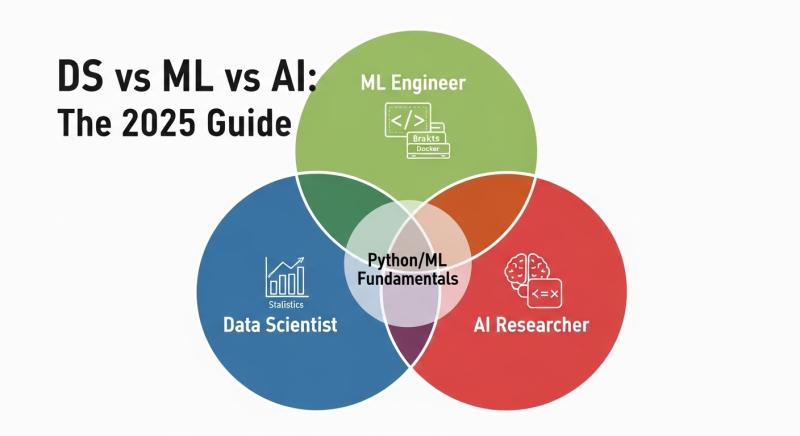
Data Scientist vs ML Engineer vs AI Researcher: Which Career Path is Right for Me in 2025?
Table of Contents (TOC)
- Introduction: The Three Pillars of Modern AI
- Role 1: Data Scientist (The Insight Generator)
- Core Focus, Key Skills, and Salary Range
- Role 2: Machine Learning Engineer (The Production Builder)
- Core Focus, Key Skills, and Salary Range
- Role 3: AI Researcher (The Innovation Pioneer)
- Core Focus, Key Skills, and Salary Range
- Choosing Your Path: A Personality-Based Guide
- Conclusion: The Intersecting Future of AI Careers
1. Introduction: The Three Pillars of Modern AI
In 2025, the terms Data Scientist, Machine Learning (ML) Engineer, and AI Researcher are often used interchangeably, but they represent three distinct, crucial phases of the Artificial Intelligence development lifecycle. Understanding these differences—from their daily tasks to their required skill sets—is key to choosing the most rewarding career path in the booming AI industry.
2. Role 1: Data Scientist (The Insight Generator)
The Data Scientist is the bridge between data and business strategy.Their primary goal is to extract actionable insights from raw data to inform decision-making.
| Feature | Description |
| Core Focus | Exploration, Analysis, and Predictive Modeling. Translating business questions into quantifiable hypotheses, cleaning complex datasets, and building initial, high-performing predictive models. |
| Daily Tasks | Exploratory Data Analysis (EDA), Statistical Testing, Hypothesis Validation, Visualization (Tableau/Power BI), and Prototype Model Building (Scikit-learn). |
| Key Skills | Strong Statistics & Math, Proficiency in Python (Pandas, NumPy, Matplotlib, Scikit-learn), SQL expertise, and Business Domain Knowledge. |
| Salary Range | Mid-Level Avg: $$115,000 - $140,000$ (Industry roles, can reach $$200k+$ at senior level) |
| Ideal For | Those who love storytelling with data, translating complex numbers into simple business strategies, and prefer statistics over systems engineering. |
3. Role 2: Machine Learning Engineer (The Production Builder)
The ML Engineer is the software engineering specialist of the AI world. Their job is to take the Data Scientist’s prototype model and turn it into a reliable, scalable, and low-latency product.
| Feature | Description |
| Core Focus | Deployment, Scalability, and MLOps. Building the infrastructure needed to run models in a real-time production environment. |
| Daily Tasks | Designing data pipelines (ETL), model serialization, deploying models via API (FastAPI/Flask), monitoring model performance (Drift Detection), and using Docker/Kubernetes. |
| Key Skills | Deep Software Engineering knowledge, Expertise in MLOps frameworks (MLflow, Kubeflow), Deep Learning Frameworks (PyTorch/TensorFlow), and Cloud Platforms (AWS/Azure/GCP). |
| Salary Range | Mid-Level Avg: $$145,000 - $180,000$ (Higher than DS due to specialized system/engineering skills) |
| Ideal For | Those with a strong programming background who want to build high-performance, resilient systems and see their models impact millions of users in real-time. |
4. Role 3: AI Researcher (The Innovation Pioneer)
The AI Researcher (often Research Scientist) is focused on advancing the state-of-the-art in the field, often working on AGI or groundbreaking deep learning architectures.
| Feature | Description |
| Core Focus | Theoretical Innovation and Experimentation. Designing novel algorithms, creating new neural network architectures, and pushing fundamental AI capabilities. |
| Daily Tasks | Reading and writing academic papers, designing complex, large-scale training experiments, prototyping novel models (e.g., Transformer variants, new RL techniques), and publishing findings. |
| Key Skills | Ph.D. or Master's degree in a quantitative field is often required. Exceptional Math (Calculus, Linear Algebra), mastery of Deep Learning Theory, and advanced programming in PyTorch/TensorFlow. |
| Salary Range | Mid-Level Avg: $$160,000 - $220,000$ (Often the highest in Big Tech R&D labs) |
| Ideal For | Those with an academic mindset who are passionate about discovering and inventing new AI techniques rather than applying existing ones to business problems. |
5. Choosing Your Path: A Personality-Based Guide
To decide which path is right for you, consider your core strengths and passion:
| If you are... | Your Ideal Role is... | Why? |
| Business-Driven & Statistical | Data Scientist | You enjoy asking "Why?" and using data (SQL, Python, Statistics) to create reports and models that directly drive revenue or solve internal business problems. |
| Software-Focused & Scalability-Obsessed | ML Engineer | You love system architecture (Docker, Kubernetes), efficient code, and the challenge of deploying and reliably maintaining complex models in production at scale. |
| Theoretically Curious & Academic | AI Researcher | You are driven by intellectual challenges, pushing the limits of current technology, and exploring novel methods that could lead to the next AGI breakthrough. |
6. Conclusion: The Intersecting Future of AI Careers
The lines between these three roles are blurring, creating hybrid roles like "Data Science Engineer." Regardless of the title, success in 2025 requires a core foundation in Python, ML fundamentals, and statistical rigor.7 Choose the role that aligns with your passion—be it generating business insights, building production systems, or inventing the future of AI—and focus on continuous upskilling to maintain a competitive edge.
| 1. Which role has the highest starting salary in 2025? |
| Answer: Typically, the Machine Learning Engineer and AI Researcher roles command the highest starting salaries, often exceeding the Data Scientist baseline, due to the high demand for specialized software engineering and deep learning skills. |
| 2. Is a Ph.D. necessary to become an ML Engineer? |
| Answer: No, a Ph.D. is not typically required for an ML Engineer; a Master's or strong Bachelor's degree with significant software engineering and MLOps experience is usually sufficient. A Ph.D. is, however, often mandatory for an AI Researcher role. |
| 3. Can a Data Scientist transition into an ML Engineer? |
| Answer: Yes, it is a very common career transition. It requires upskilling in core software engineering, system architecture, MLOps tools (Docker, Kubernetes), and focusing less on statistical analysis and more on writing production-grade, scalable Python code. |

